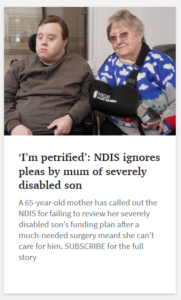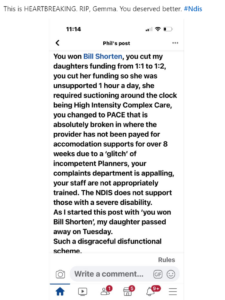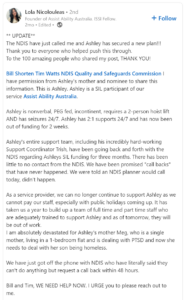How “Saving Money” Could Result in Further NDIA Planner Failure
Just after the budget release, Minister Bill Shorten announced a $14 billion saving by eliminating “Automatic NDIS Top-Up’s”. “I have never had an automatic plan top-up,” you might say. Many might agree that if you spend all of your funding, you shouldn’t automatically be topped up to spend more in the same plan period. This so-called “Intraplan Inflation” is precisely what the Minister is targeting.
However, Minister Shorten conveniently ignores critical factors about intraplan inflation and plan top-ups that affect a very vulnerable population of NDIS participants—those receiving 24-hour support, such as Supported Independent Living (SIL), Individual Living Options (ILO), or extensive Core Daily Living Supports.
The Perils of Plan Review for Vulnerable Participants
To understand the potential dangers to participants with Home and Living Support, we need to clarify the current plan review process.
If you’re among the fortunate few, the NDIS won’t tell you your parents or caregivers must look after you until they die. You’ve received some level of funding in the past, but now your circumstances have changed. Your aging parents, now in their 70s, can no longer provide consistent support. Perhaps your mother has a medical diagnosis, and your father is her sole carer. Unable to care for you, they submit a Section 48 (s48, change of circumstance).
You wait a few days after expressing the urgency to the NDIA, only to be met with silence. You call the NDIA: “Hello, I’m in a crisis and need urgent support funding.” The NDIA planner replies, “Sorry, we can’t increase your funding without Home and Living Assessments. Use your existing funds to hire support workers until you provide evidence of your need.”
Forced to spend your funding faster than intended, you move in with an Accommodation/SIL provider to meet your support needs. After months of waiting due to limited occupational therapy (OT) capacity, you finally get an OT report. You submit all health professional reports to the Home and Living Team, a special NDIA branch harder to access than the Minister himself. Your Section 48 (s48) request sits with the NDIA for months, all the while, still stuck with inadequate funding.

link to story : NDIS Ignores Pleas
The Bureaucratic Nightmare
Now, you request a plan “top-up” to pay your support workers while waiting for reassessment. This intraplan inflation becomes a concern. Pulled directly from the NDIA website; plan extensions are still a possibility, however, the looming NDIS Bill, driven by a government focused on recouping fraudulently spent funds, aims to reduce or delay funding increases for the disability population’s most vulnerable. The average package for participants with SIL funding is significantly higher than those without it.
The NDIA has started to push the narrative that dodgy or fraudulent providers are responsible for intraplan inflation, particularly focusing on Plan Managers. However, this rhetoric is already causing damage by using the issue of plan top-ups to prevent SIL participants from receiving necessary support. NDIA planners are increasingly subscribing to this message as an excuse to deny essential support to participants with higher intensity needs.
The Review Process: A Battle Against Incompetence
Let’s assume your plan reaches a planner for reassessment in the timeframe prescribed by the NDIA. If lucky, they read the submitted reports, and you get Home and Living Funding. However, what we seem to repetitively see is planners not reading reports, or worse, relying on an internal NDIA tool, to grant inadequate funding in contrary to the provided evidence from health professionals.
Stuck with inadequate funding? You can submit a Section 100 (s100) review. But the NDIA delays processes longer than the Cold War. You need 24-hour support at a 1:1 ratio but receive funding at a 1:3 ratio (that’s what the internal NDIA tool spat out), forcing you to submit a Section 100. And then you wait…and wait…and wait.
The Endless Waiting Game
The timeline for a Section 100 review is mandated by the NDIA, but they rarely adhere to it. After countless calls, you might finally reach a planner, only to hear they agree with their colleague. Meanwhile, you’ve spent your 1:3 budget on 1:1 supports, depleting your funds in four months instead of twelve.
Out of options, you head to the Administrative Appeals Tribunal (AAT). Though participants often win, the NDIA’s incompetence has created a backlog, with cases taking over 18 months to be heard. You’re left spending inadequate funding while battling the NDIS, necessitating more “top-ups” due to exhausted funding in this war with the NDIS.
The Fight for Justice
Even if you get a top-up, waiting for the AAT can be lengthy. The NDIA, unhappy with losing at AAT, hired high-paid legal attack dogs (NDIS Mediators) to bully participants into giving up. Miraculously, if the Mediators agree with your original reports, you might have a quick resolution. More likely, you’ll eventually win and receive the necessary supports after two years of battling for what you deserved initially.
The Harsh Reality of Eliminating Top-Ups and Enforcing Plan Cuts
This story, though not specific, reflects many participants’ experiences through various advocacy channels. What happens if automatic top-ups are removed? The above scenario had three top-ups due to lengthy timelines for OT reports, Section 48 decisions, Section 100 decisions, and AAT rulings. Without these top-ups, detrimental effects like homelessness, safety risks, and even death are probable. Participants have already died due to this inefficiency many have died waiting for acceptance to the scheme.

The High Cost of Inadequate Funding
A participant requiring 1:1 24-hour support might need anywhere from $500,000 to $600,000 per year. This equates to approximately $9,615 per week. According to the disability support worker cost model, only 8% of this amount is profit for the SIL provider, translating to $40,000 annually for a participant with $500,000 in SIL funding.
If a participant is left unfunded for just five weeks, the provider is put into significant financial strain. The ethical dilemma for providers becomes stark: either continue supporting a participant without adequate funding and risk financial ruin; or terminate services, leaving the participant to fend for themselves. This dire situation unfolds while the NDIA sits on their hands, complaining about the volume of funding reviews.
The NDIA’s bureaucratic inefficiency forces providers into impossible positions, undermining their ability to deliver necessary support and jeopardizing the well-being of participants who rely on consistent, adequate funding to survive.


Conclusion: A Broken System
Minister Shorten claims participants facing immediate safety risks will have their plans topped-up or extended. Yet, the Department of Social Services, the NDIA, and the Minister’s office seem to disagree on what constitutes a top-up, leaving the disability community waiting for the next debacle. Hopefully, a resolution arrives before more lives are lost to the system’s incompetence.
The rhetoric around plan top-ups being unnecessary or indicative of fraud is dangerous. Planners and the NDIA need a better understanding of the necessity of top-ups for participants under the lengthy review process. They are not just bureaucratic formalities but critical lifelines that ensure participants with high-intensity needs receive the support they require. Without this understanding, the most vulnerable participants are left at significant risk.


